They say… 
Best beer and travel writing award 2015, 2011 -- British Guild of Beer Writers Awards
Accredited Beer Sommelier
Writer of "Probably the best book about beer in London" - Londonist
"A necessity if you're a beer geek travelling to London town" - Beer Advocate
"A joy to read" - Roger Protz
"Very authoritative" - Tim Webb.
"One of the top beer writers in the UK" - Mark Dredge.
"A beer guru" - Popbitch.

|
Pré-ZBF Festival 2010
ABV: 8%
Origin: Woesten-Vleteren, West-Vlaanderen
Website: http://struise.noordhoek.com
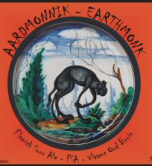 De Struise Aardmonnik De Struise Brouwers, a beer firm that work mainly on the plant of the Deca brewery, are the enfants terribles of Belgian brewing, more appreciated by the international “extreme beer” crowd than within Belgium itself for their eccentric, often strong and sometimes barrel-aged ales. The name means “ostrich”, recalling the fact that the owners’ other enterprise is an ostrich farm, but the word is also slang for “tough”, explaining their self-translated English strapline “the sturdy brewers”.
Aardmonnik, or Earthmonk, is a rare occasional strong brown ale aged in oak for 18 months — it’s not been around for a while but it appeared on draught at the Pré-ZBF event this year. It’s a very dark brown beer with a generous foamy beige head and a sourish bretannomyces-laced brown malt aroma, evidence of its long ageing. A lightly balsamic palate has chewy cherry and vine fruits, wood tones, toffee and a slight nuttiness, with just a hint of smoky bacon. A lovely sappy moreish finish has a smack of burnt plastic and some subtle smokiness, staying nice and tart around the mouth. Despite its wacky reputation this is actually ends up quite a traditional Flemish brown ale, albeit on the very strong and vivid side, and given the shrinking ranks of that particular style, is most welcome. A shame it’s limited to 5,000 bottles every two years.
Pré-ZBF Festival 2010
ABV: 5.3%
Origin: Heule, West-Vlaanderen
Website: www.alvinne.be
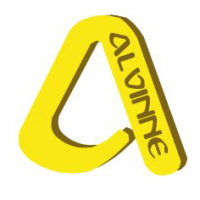 Picobrouwerij Alvinne The latest collaboration between the Alvinne “picobrewery” and beer writer, tour organiser and all-round personality Chris “Podge” Pollard is this beer intended primarily for the Chelmsford Beer Festival, a combination of Belgian flair and some decidedly local links to Podge’s Essex stomping ground. The malt was procured from Bairds’ Witham plant, smoked in Colchester and taken across to West Flanders late last year by Podge on one of his tours, with the beer first making its appearance at Alvinne’s Pré-ZBF event, where it was one of the lower gravity offerings, served bottle conditioned from the bottle.
Surrounded by extreme beers with big flavours, this one turned out to be remarkably restrained and modest. It poured a cloudy dark brown with a foamy fawn head and relatively gentle dark malt aroma with light smoke and banana yeast hints. A very dry woodsmoke palate was very nicely balanced with toast, oaky notes and a nice fresh and relatively light texture, and also some phenolic and banana esters. The sappy finish turned notably dry, the smoke offset by burry hop flavours (the beer has a relatively generous 50EBU), with some late ash and cindery tones. A subtle beer that riffs well on the smoky theme already inherent in some porters — if you’ve found smoked beer just too odd in the past, this might be your way in.
Read more about this beer at ratebeer.com: http://www.ratebeer.com/beer/alvinne-chelmsford-oak-smoked-porter/119281/
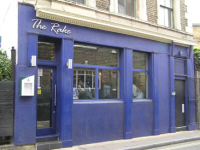 The Rake, London SE1 The Rake, a tiny pub on the edge of London’s Borough Market, is a serious specialist beer venue that in a few short years has become one of the UK’s main attractions for the international beer appreciation circuit, a must-do on the itinerary. The first day of the pub’s annual Welsh beer festival on the Sunday before St David’s Day saw a surprisingly high concentration of brewers, beer writers and bloggers and sundry geeks mixing with those ordinary folk who simply like a good pint. There were even brewing visitors from Hawaii – Garrett and Melanie Marrero of the lauded Maui brewpub.
The day included a Meet the Brewer tasting event, part of a series run upstairs at the pub by the irrepressible beer writer, TV personality and blogger Melissa Cole under the banner lovebeer@borough. The brewer in question was Justin “Buster” Grant of Breconshire Brewery, a true expert (among other things he’s a mainstay of CAMRA’s technical panel) as well as enthusiast, and an articulate and engaging presenter of his own beers, demonstrating the intelligence and imagination behind them. Buster guided us through six of his beers, five bottle conditioned and the sixth an advanced polycask sample of the remarkable cask only Ysprid y Ddraig, a subtle and luscious wood-aged blond.
Downstairs an impressive selection of around 20 Welsh cask beers, mainly served straight from casks out on the heated terrace, demonstrated just how far the country’s brewing scene has developed since the days of dry counties and big beer factories. The likes of Breconshire, Otley, Conwy, Mŵs Piws and Bryncelyn toasted St Dewi in with style.
Selected tastings:
- [intlink id=”620″ type=”post”]Breconshire Ysprid y Ddraig[/intlink] 6.5%, Aberhonddu, Powys, Cymru
- [intlink id=”623″ type=”post”]Tudor Blorenge[/intlink] 4.4%, Y Fenni, Sir Fynwy, Cymru
Rake Welsh Beer Festival February 2010
ABV: 4.4%
Origin: Y Fenni, Sir Fynwy, Cymru
Website: http://www.tudorbrewery.co.uk/
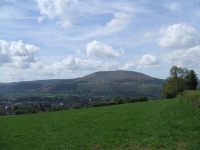 The Blorenge. http://www.flickr.com/photos/jemwilliams/ / CC BY-NC-ND 2.0 I must confess I’d not heard of this brewery, one of a number of new Welsh micros, and chose the beer from the cask selection at the Rake festival largely on the grounds of its relatively low ABV, not wanting to undermine my faculties before a serious tasting. I was mightily pleased with what I got. British micros have become adept at churning out session strength golden beers they hope will lure the lager drinkers, and some of them are becoming rather uninspired and uninspiring, so Blorenge was a particularly pleasant surprise.
The beer poured a slightly hazy mid-gold with a foamy white head and a lightly perfumed elderflower aroma. The dry and lightly bitter palate had firm malt and refreshing herbal notes, bitter but not overly so, leading to a herby finish that was surprisingly smoky, given the colour, and slightly gritty, with biscuit and mineral flavours. A light-hearted, refreshing and very well made golden ale.
I’ve since discovered it originates from a brewery established in 2007 at the Kings Arms pub in Y Fenni / Abergavenny, taking its name from the town’s Tudor gate. Like Blorenge, the other beers are named after mountains in the nearby Brecon Beacons national park — if this example is anything to go by, they’re certainly aiming for the heights of brewing skill.
Read more about this beer at ratebeer.com: http://www.ratebeer.com/beer/tudor-blorenge/99524/
Rake Welsh Beer Festival February 2010
Top Tastings 2010
ABV: 6.5%
Origin: Aberhonddu, Powys, Cymru
Website: www.breconshirebrewery.com
 Breconshire Ysprid y Ddraig Breconshire Brewery under the leadership of brewer Justin “Buster” Grant has become one of the best breweries in Wales, mixing innovation with consistency and a sense of tradition and place. Buster is adept at making easy going session beers with a stylish twist, but with Ysprid y Ddraig he proves capable of more esoteric specialities too, joining the growing international band of innovative brewers discovering the delights of ageing in wooden casks. In this case the casks in question are refill Scotch malt whisky – the name means Spirit of the Dragon, with “ysprid” having the same double meaning in Welsh that “spirit” has in English. It’s an appropriate label for a malt cask beer made in Wales by a Scotsman.
Like many of Buster’s beers, this is light in colour. He’s clearly fascinated by how much flavour he can get out of a golden beer, such as Ramblers Ruin which has the distinct bite of black and roasted malt, and he’s still puzzling over how to brew a blond Schwarzbier. First made last year to great acclaim by those in the know, it remains an occasional cask-only treat – ours was an advance sample of the second brew, in a polycask and still slightly too young.
It’s a warm gold in colour with very little head, and a flowery grapefruit and honey aroma with clear notes of whisky and sherry – in fact like many whisky casks the one in question once held sherry. A very smooth and honeyed palate with a firm wine-like body and some wheaty notes develops lots of fruit and twiggy, spicy hops, with very gentle whisky notes providing a hint of sophistication. The casking is more obvious on the long, well-balanced and slow developing finish, emerging as charred oak alongside tasty fruit, with a very late note of hops. Unlike with some beers in the style, the spirit remains subtle and elegant throughout, and shouldn’t cause you to breathe too much fire.
Read more about this beer at ratebeer.com: http://www.ratebeer.com/Ratings/Beer/Beer-Ratings.asp?BeerID=90722
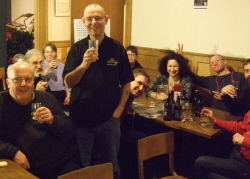 Des de Moor and CAMRA North London tasters, Wenlock Arms, London N1, February 2010. Photo: John Cryne Visiting a great beer pub like the Wenlock Arms, in London N1 on the uncertain border between Hoxton and Islington, reminds me I don’t go to the pub enough. And I wasn’t even here to enjoy its ragged but relaxed atmosphere and excellent selection of top quality cask beers (always including at least one mild), but to host a bottled beer tasting at the behest of North London CAMRA.
A good bunch of people, of mixed ages and genders, found their way to the upstairs room to sample eight Real Ales in a Bottle that I’d chosen to demonstrate both range and quality, including a couple of Champion Bottled Beer of Britain winners. The obliging people at realale.com and alesbymail.com provided most of the supplies and Fuller’s had very generously dug out a case of aged Vintage Ale. Unsurprisingly this proved to be most people’s top beer of the evening, but there was also much satisfied humming for Hoggleys Mill Lane Mild, while Hopback Crop Circle and Red Squirrel IPA in the USA split opinions.
If you’re interested in attending future tastings, watch this space.
The Beer List:
- [intlink id=”265″ type=”post”]Cropton Two pints[/intlink] 4% Cropton, North Yorkshire, England
- [intlink id=”548″ type=”post”]Hop Back Crop Circle[/intlink] 4.2% Downton, Wiltshire, England
- [intlink id=”555″ type=”post”]Hoggleys Mill Lane Mild[/intlink] 4% Litchborough, Northamptonshire, England
- [intlink id=”567″ type=”post”]St Austell Admiral\’s Ale[/intlink] 5% St Austell, Cornwall, England
- [intlink id=”582″ type=”post”]Titanic Stout[/intlink] 4.5% Stoke, Staffordshire, England
- [intlink id=”416″ type=”post”]Red Squirrel IPA in the USA[/intlink] 5.4% Hertford, Hertfordshire, England
- [intlink id=”598″ type=”post”]Downton Chimera India Pale Ale[/intlink] 7% Downton, Wiltshire, England
- [intlink id=”353″ type=”post”]Fuller\’s Vintage Ale[/intlink] 2004 8.5% Chiswick, London, England
ABV: 4.6% and 4.7%
Origin: Ansley, Warwickshire, England
Website: www.tunnelbrewery.co.uk
Originally published in BEER, February 2007, as part of a review featuring reader recommended beers. For more, see previous post.
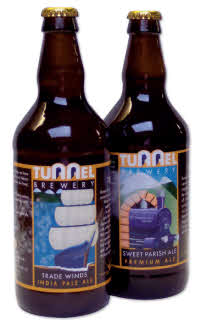 Tunnel Trade Winds and Sweet Parish Ale The Tunnel Brewery at the Lord Nelson Inn at Ansley, near Nuneaton in one of the more rolling and rural parts of Warwickshire, is a true enthusiast-driven operation. It owes its foundation to a group of friends who attended beer connoisseur classes at a local catering college.
The whole group pitched in to finance the brewery at the Lord Nelson, which, with the additional help of a grant from Defra, first fired up its mash tun in 2005 with Mike Walsh – tutor of said classes – as head brewer. Real Ale in a Bottle followed in 2006 and Tunnel’s reputation has continued to grow ever since.
Something of everything they brew goes into bottles, and I picked out two from a wide and varied range. Trade Winds – an IPA at a more contemporary, lower gravity with a nod across the Atlantic – makes an interesting comparison with Downton’s stronger interpretation discussed above.
It’s a warm golden-amber beer with a bubbly off-white head and a moderate, slightly grassy hop aroma with some pineapple and vanilla notes, also made with pure Maris Otter pale malt, and Cascade hops added twice during the boil.
Piney, citric hop notes soon assert themselves on a nicely malty palate, developing a peppery bitterness. The hopping remains prominent, though not overly so, on a slightly sweetish gingery finish with another citrus squeeze. While lacking the complexity of stronger IPAs, it provides easy drinking without sacrificing the hop impact.
Sweet Parish Ale, designated a “premium bitter”, is better still. It’s another Maris Otter product, this time coloured by a little crystal, with East Kent Goldings hops on the boil and Styrian Goldings for aroma.
The result is a deep reddish brown, with a thick yellow head that subsides to persistent bubbles. There’s a refreshing sharply fruity whiff on a notably malty aroma, with blackcurrant pastille notes.
The biscuity gingerbread palate also boasts nuts, fruit, slight smokiness and a touch of herbal cough pastille complexity. A refreshing swallow leads to a dry, leafy finish with well-balanced hops, faint roast and plenty of juicy fruit.
The stylish label designs include lengthy and imaginative but wholly spurious explanations of each beer’s origins under the heading “Rumour has it…”, penned by brewery partner Bob Yates. While I’m the sort of killjoy that would prefer some of the space to be given to more factual information, these pieces are eccentrically engaging and certainly contribute to brand identity.
The bottles also display numbers indicating the order in which the recipes were launched – the pair above are numbers 3 and 2 respectively – a ploy guaranteed to engage the collecting instinct. Bob reports that they now receive requests for samples of bottles and beer mats from all around the world.
If rumour has it that Tunnel brews some very good beers, you can be sure that on this matter at least, the rumours are true.
Read more about these beers at ratebeer.com:
http://www.ratebeer.com/beer/tunnel-tradewinds-ipa/51661/
http://www.ratebeer.com/beer/tunnel-sweet-parish-ale-spa/48933/
ABV: 6% and 7%
Origin: Downton, Wiltshire, England
Website: http://www.hampshirebrewery.com/
Originally published in BEER, February 2007
CAMRA North London tasting February 2010 (IPA only)
 Downton Chimera Dark Delight and India Pale Ale As sharp-eyed readers will have noticed, this page has for some time carried an open invitation for beer suggestions by email, all of which are gratefully received. Both breweries featured this month came to my attention through reader recommendations.
Hop Back brewery once used to boast it was the only brewery in Downton, a large and historic village (or town, depending on who you ask) near Salisbury. It lost that distinction in 2003 when a new micro opened on the very same industrial estate.
Far from being a hostile rival, however, Hop Back has been a friendly neighbour – in fact Downton brewer Martin Strawbridge once worked for the bigger brewery. Hop Back leased Downton space and plant, and bottle and sell its beers.
Two impressive real ales are offered in a bottle under the Chimera brand name. Dark Delight is an old ale that was a Tesco beer challenge runner up in 2004, and became Downton’s second bottled beer in November last year.
A grist of Crisp Norfolk-grown Maris Otter pale malt, maize, roast barley, crystal wheat malt and chocolate malt from Warminster maltings is hopped with Challenger and East Kent Goldings, with a late dose of Pioneer for aroma.
The beer is a rich deep chestnut colour with ruby hints and a light off-white foamy head. The aroma is generously malty and chocolatey, developing a chaffy cereal note and lightly perfumed raspberry fruit.
The palate is surprisingly light hearted, with moist fruit cake, Demerara sugar, a blast of dry coffee and spicy ginger and cinnamon notes. A dry leafy finish has a hint of roast, leaving the impression of a full-bodied but very drinkable beer.
The brewery’s other bottled beer is an award-winning revivalist India Pale Ale, with a golden colour, robust gravity and generous use of hops recalling the late 18th century founders of the style. East Kent Goldings and Pioneer do the honours, with a dash of Organic Fuggles for aroma in more recent brews and a grist of pure Maris Otter with a dash of maize.
My bottled poured a lightly cloudy yellow gold, with a fine bubbly white head. Oddly, the perfumed hoppy aroma turned out to have something of a Germanic character, with honeyed and vanilla notes.
A crisp but quite soft, full and sweet palate is quick to turn hoppy, with resins, pepper, hints of pineapple and a slightly soapy note that isn’t at all unpleasant.
Hops persist in the finish which is peppery and twiggy, but again with that sweetish malt to soften things out. A little more sweetness would have been cloying, but instead the beer manages a perfect balance with vivid flavours.
The Chimera itself puts in an appearance on both labels – an impossibly monstrous creature from Greek mythology with the heads of both a goat and a lion, and a snake for a tail. The beers also bring together disparate ingredients, but with a considerably more harmonious and agreeable result.
For more reader recommended beers see next post.
Read more about these beers at ratebeer.com:
http://www.ratebeer.com/beer/downton-chimera-dark-delight/43300/
http://www.ratebeer.com/beer/downton-chimera-india-pale-ale/44496/
ABV: 3.9%
Origin: Liverpool, Merseyside, England
Website: http://www.wappingbeers.co.uk
Originally published in BEER October 2007 as part of a review of that year’s Champion Bottle Conditioned Beer of Britain winners. For more see previous posts.
 Wapping Baltic Gold One beer bucked the dark trend among this year’s medallists, and from an unfamiliar name that prompted a few puzzled looks among the assembled scribbling experts at the GBBF awards ceremony. Bronze winner Wapping is the modest microbrewery at the historic Baltic Fleet pub on Liverpool’s regenerated dockside which for the past six years has mainly brewed cask for the pub – bottling is a new activity, accomplished by hand straight from the fermenters.
Baltic Gold is a light golden hoppy beer with shades of a US craft-brewed pale, in sharp contrast to the stouts but also of impressive quality. There’s a lovely creamy, slightly floury malt and nettly hop aroma – it’s a single hop, but brewer Stan Shaw prefers not to say which.
The palate is crisp and almost Riesling-like, slightly salty with rich vegetal and resiny hop flavours turning bitter in the mouth, with a gentle condition like a fresh draught pint. A refreshing swallow leads to a lemony finish that turns bitter and peppery over soft, juicy malt.
Stan and owner Simon Holt were as surprised as anyone to see their beer emerging triumphant among such well-known names, but it well deserves its placing. And it’s reassuring too that a blind-tasted competition like the Champion Beer of Britain can turn up talented newcomers regardless of style.
Read more about this beer at ratebeer.com: http://www.ratebeer.com/beer/wapping-baltic-gold/71242/
ABV: 4.6%
Origin: Stoke Lacy, Herefordshire, England
Website www.wyevalleybrewery.co.uk
Originally published in BEER October 2007 as part of a review of that year’s Champion Bottle Conditioned Beer of Britain winners. For more see previous posts.
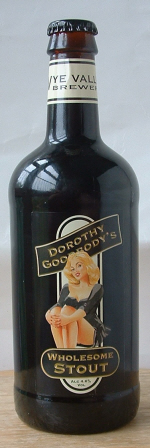 Wye Valley Dorothy Goodbody's Wholesome Stout Wye Valley is another name well-known to fans of British RAIB, especially for its Dorothy Goodbody brand – named after a fictitious blonde bombshell whose 1940s-retro image graces the brewery’s flagship brands. Its cask beers are also well-appreciated, but this year’s joint silver medal is its first CBoB award for bottled beer, and not before time.
Wholesome Stout, brewed from Maris Otter pale, crystal and chocolate malt plus roasted and flaked barley and hopped with only Northdown, is a very dark brown beer with a thick creamy fawn head, and an amber tinge in the light. There’s firm malt, roast and coffee in a tangy, fruity aroma.
A classically roasty dry stout palate has good acidity and an early hop note, while a mild and fruity underlying maltiness is slightly kinder than the Titanic beer. There’s still plenty of edgy roast dryness on the lengthy finish, with a rooty hop bite again softened by malt. Memory may be unreliable, but I can’t recall ever tasting an old-fashioned Guinness as rich and complex as this.
For more Champion Bottle Conditioned Beer of Britain winners, see next post.
Read more about this beer at ratebeer.com: http://www.ratebeer.com/beer/wye-valley-dorothy-goodbodys-wholesome-stout/5808/
|
Cask  This pioneering new book explains what makes cask beer so special, and explores its past, present and future. Order now from CAMRA Books. Read more here. This pioneering new book explains what makes cask beer so special, and explores its past, present and future. Order now from CAMRA Books. Read more here.
London’s Best Beer  The fully updated 3rd edition of my essential award-winning guide to London’s vibrant beer scene is available now from CAMRA Books. Read more here. The fully updated 3rd edition of my essential award-winning guide to London’s vibrant beer scene is available now from CAMRA Books. Read more here.
|














